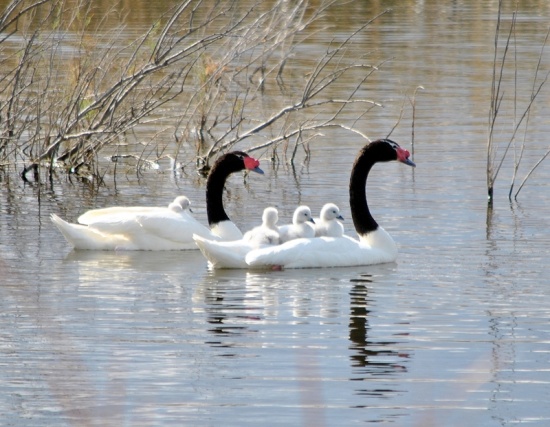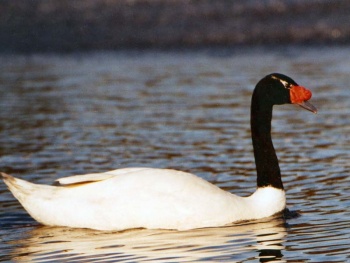(→Identification: Imperial units.) |
|||
| Line 21: | Line 21: | ||
[[Image:Black-necked_Swan.jpg|thumb|350px|right|Photo © by {{user|Fritz73|Fritz73}}<br />[[Costanera Sur Ecological Reserve]], Buenos Aires, [[Argentina]], 2003]] | [[Image:Black-necked_Swan.jpg|thumb|350px|right|Photo © by {{user|Fritz73|Fritz73}}<br />[[Costanera Sur Ecological Reserve]], Buenos Aires, [[Argentina]], 2003]] | ||
====Breeding==== | ====Breeding==== | ||
| − | The nest is a mound of vegetation. The clutch consists of four to | + | Breeds from July to August and mates for life. The nest is a large mound of vegetation usually in reed-beds close to the water's edge. The clutch consists of four to seven eggs incubated by the female. |
| + | |||
====Diet==== | ====Diet==== | ||
The diet includes vegetation, insects and fish spawn. | The diet includes vegetation, insects and fish spawn. | ||
Revision as of 21:13, 21 January 2019

Photo © by Julian Tocce
Lago Pellegrini, Río Negro, Patagonia, Argentina, 10 October 2015
- Cygnus melancoryphus
Identification
Males - 115-140 cm (45½-55 in); females - 102-124 cm (40- 49 in)
- White body
- Black neck and head
- Greyish bill
- Red knob near base of bill
- White stripe behind eye
Cygnet - Plumage light grey, bill and feet black.
Distribution
South America: found in Brazil, Chile, Argentina, Tierra del Fuego and the Falkland Islands.
Taxonomy
This is a monotypic species[1].
Formerly placed in the monospecific genus Sthenelides. The specific name is sometimes misspelled melanocorypha, e.g. by HBW, Sibley & Monroe and others. The change to melancoryphus was necessitated for gender agreement when the species was moved to Cygnus but melanocoryphus was used by Clements until the 2007 revision of their sixth edition and that misspelling is common in older publications.
Habitat
Freshwater marshes, lagoon and lake shores.
Behaviour
Breeding
Breeds from July to August and mates for life. The nest is a large mound of vegetation usually in reed-beds close to the water's edge. The clutch consists of four to seven eggs incubated by the female.
Diet
The diet includes vegetation, insects and fish spawn.
References
- Clements, J. F., T. S. Schulenberg, M. J. Iliff, D. Roberson, T. A. Fredericks, B. L. Sullivan, and C. L. Wood. 2018. The eBird/Clements checklist of birds of the world: v2018. Downloaded from http://www.birds.cornell.edu/clementschecklist/download/
- Avibase
- Wikipedia contributors. (2018, August 22). Black-necked swan. In Wikipedia, The Free Encyclopedia. Retrieved 09:38, January 21, 2019, from https://en.wikipedia.org/w/index.php?title=Black-necked_swan&oldid=856019686
- Carboneras, C. & Kirwan, G.M. (2019). Black-necked Swan (Cygnus melancoryphus). In: del Hoyo, J., Elliott, A., Sargatal, J., Christie, D.A. & de Juana, E. (eds.). Handbook of the Birds of the World Alive. Lynx Edicions, Barcelona. (retrieved from https://www.hbw.com/node/52805 on 21 January 2019
- Black-necked Swan (Cygnus melancoryphus), In Neotropical Birds Online (T. S. Schulenberg, Editor). Cornell Lab of Ornithology, Ithaca, NY, USA. retrieved from Neotropical Birds Online: https://neotropical.birds.cornell.edu/Species-Account/nb/species/blnswa2
Recommended Citation
- BirdForum Opus contributors. (2024) Black-necked Swan. In: BirdForum, the forum for wild birds and birding. Retrieved 19 April 2024 from https://www.birdforum.net/opus/Black-necked_Swan





